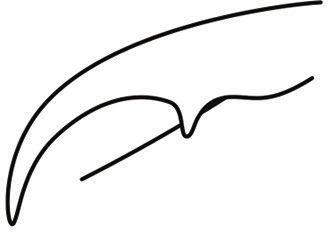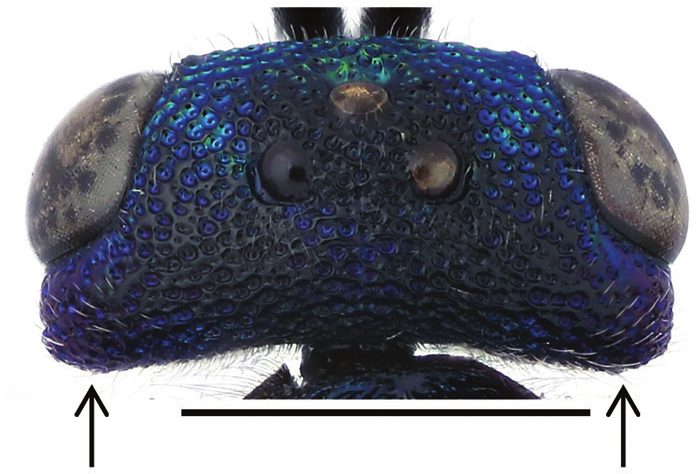Hedychridium roseum
The species is rather common along sandy roadsides and dry slopes where the host Astata boops is living. Hedychridium roseum is very characteristic with the red tergites without metalic reflection. It can only be confused with H. caputaureum.
- Innhold
- Diagnosis
- Distribution
- Biology
Diagnosis
Figure 5
Tarsal claw: Hedychridium roseum.
Figure 74
Head, dorsal view (arrows indicating temples): H. roseum ♀. Scale 1 mm.
Length 5–8 mm.
The species differs from H. caputaureum by having the vertex (Fig. 74) and mesosoma completely blue or greenish, sometimes nearly black, without any trace of coppery red colour. Some males, however, have golden reflections on the pronotum and mesoscutum. The punctation of the tergites is finer and denser throughout, not becoming coarser posteriorly on T2 and T3 as in most males of H. caputaureum. The metasoma is similarly non-metallic red or orange as in H. caputaureum, and may have weak metallic violet reflections posteriorly.
Distribution
Denmark, Estonia, Finland, Latvia, Lithuania, Norway, Sweden. Common.
Trans-Palearctic: from western Europe to Siberia, China and Russian Far East (Linsenmaier 1959, Kurzenko and Lelej 2007, Rosa et al. 2014).
Be aware that the records present in the GBIF map may be misleading for some countries due to unrevised data sets or missing information.
GBIF Taxon: Hedychridium roseum (Rossi, 1790)Biology
Habitat: sparsely vegetated sandy areas, dry meadows. Adults visit flowers of Apiaceae, Asteraceae, Crassulaceae and Euphorbiaceae (Trautmann 1927, Kusdas 1956, Heinrich 1964, Brechtel 1985, Linsenmaier 1997, Rosa 2004).
Flight period: late June to late August.
Host: primarily Astata boops (Schranck) (Crabronidae) (Reder 2010, our own obs.), but possibly also Dryudella stigma (Panzer), Tachysphex pompiliformis (Panzer) and Harpactus tumidus (Panzer) (Crabronidae) (Shuckard 1837, Müller 1918, Forsius 1925, Doronin 1996, Saure 1998).


